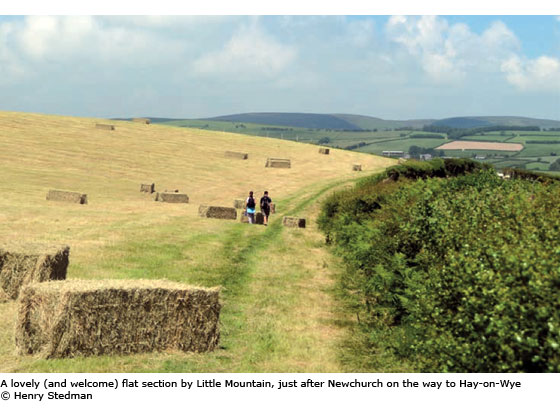Trailblazer guidebooks provide practical information on specific routes in less accessible parts of the world.
— Wanderlust

Offa's Dyke Path: Chepstow to Prestatyn & Prestatyn to Chepstow
Excerpt:
About the Offa's Dyke Path
Contents | Introduction | About the Offa's Dyke Path | Planning your walk | Using this guide | Sample route guide: Bodfari to Clwyd Gate
The Offa's Dyke Path National Trail
The Offa's Dyke Path was the fourth of 15 national trails to be established in England and Wales, with a further four in Scotland.
The first of these trails, the Pennine Way, was opened in 1965 but it was not until 1971 that Lord Hunt, of Everest fame, officially opened the Offa’s Dyke Path.
The path was originally the responsibility of the Countryside Commission, but as the path crosses the English/Welsh border many times, two-thirds being in Wales and one third in England, the responsibility for it passed to the Countryside Council for Wales in 1991.
It is managed and maintained by the Offa’s Dyke Path Management Service based in Knighton, with the close co-operation of the local authorities through whose land it passes.
Strangely, the distance covered by the path is a matter for conjecture: you will see various figures given for the length of the path – 182 miles according to the sign in Chepstow, 177 miles according to the official National Trail website and 168 miles if you believe what is written at Sedbury Cliffs.
How difficult is the Offa’s Dyke Path?
Do not be deceived into thinking this is an easy walk. A level of fitness and walking competence is required for most sections of the Offa’s Dyke Path. It’s 177 miles end to end and assuming you have two weeks available this will require an average of nearly 15 miles a day, based on 12 days of walking plus a day to get to the start and a day to get home.
That's about five to seven hours’ walking every day. On at least three days you will probably have to walk 17 miles; quite a tall order and you are going to feel a certain amount of tiredness at the end of the walking day. Are you up to it?
There are three severe and testing sections, two of which involve exposed crossings well away from human habitation. The first is the crossing of the Clwydian Range (see pp94-101) from Bodfari to Clwyd Gate which involves several climbs and descents as well as some incomparable ridge walking.
On a fine day you will romp it but in bad weather it can be a severe test of endurance. Luckily there are several escape routes enabling you to arrange a pick-up, possibly by your B&B host for the night.

The second challenging section is along Hatterrall Ridge in the Black Mountains (see pp187-200) between Hay-on-Wye and Pandy. It’s a distance of 17½ miles (28km) through exposed country, the highest point being 703m (2306ft), and can take up to 10 hours. There is little shelter and only a few escape routes although the journey could be broken at Capel-y-ffin or Llanthony.
You will need to think carefully about how you are going to tackle this arduous crossing. The last of the three – the so-called ‘Switch-backs’ (see north and south of Knighton, pp150-166) – falls into a different category: while most of the ups and downs on this section are par for the course, others, particularly north of the town, will pose a considerable challenge for many Dyke walkers.
That said, anyone possessing basic outdoor competence should find themselves coping perfectly well even with these challenging sections but don’t underestimate any part of the route; it is not a doddle.
How long do you need?
This is the great imponderable. Can the path be walked from end to end in a fortnight’s holiday? The answer is yes, definitely, but a lot will depend on your travelling time.
If you have just 14 days but need two of those for the journey to and from the trail, you’ll have to get a move on and it won’t leave you much time to stop and stare. No time to visit Chirk Castle, see Llangollen, go into Montgomery, call in at the Offa’s Dyke Centre in Knighton, shop for second-hand books in Hay-on-Wye, have a pint at the Boat Inn at Redbrook or the Three Tuns in Bishop’s Castle. This is good country and it deserves more than a hurried glance.
The walk will be much more enjoyable if you can spare a full 14 days walking, plus a day or two for travelling to and from home, so if your fortnight’s holiday incorporates three weekends, you’re in luck. If not, you could reasonably leave out one or two of the less-inspiring sections without losing any of the essential character of the route.
Prestatyn to Bodfari (pp88-94), Castle Mill to Llanymynech (pp122-130) and the section along the Severn plain (pp134-7) are all contenders for omission if you’re in a hurry, as is the very last section of the walk, beyond Chepstow (p230). See also suggested itineraries (p36).
If you can’t spare the time to walk from end to end in one go you could undertake the walk over several shorter trips, gradually accumulating the miles until the great day comes when you have completed it in its entirety.
Another option is simply to sample the highlights of the route on day walks and weekend trips; see pp35-7 for a list of recommended sections.
Offa's Dyke Path: Chepstow to Prestatyn & Prestatyn to Chepstow
Excerpts:
- Contents
- Introduction
- About the Offa's Dyke Path
- Planning your walk
- Using this guide
- Sample route guide: Bodfari to Clwyd Gate
Latest tweets